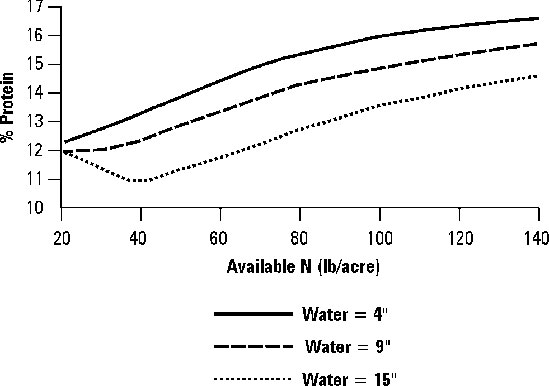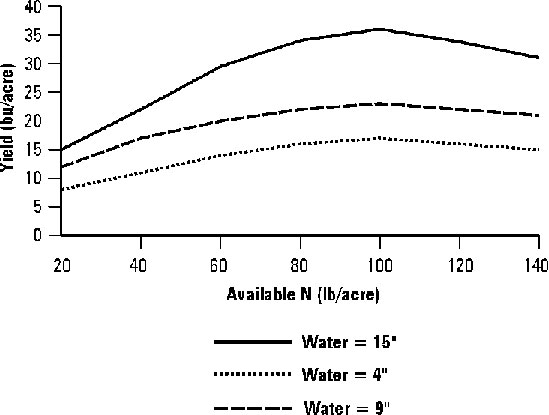| | Factors affecting protein content | Fertilization | Genetic potential of the wheat variety
Canadian hard red and durum wheats have long been recognized as premium quality grains by the milling and pasta industries. This quality is due primarily to the protein component of the grain.
The protein premiums offered on these classes of wheat show how each increase in protein level leads to better returns for the producer (see Table 1). Protein premiums are paid on 0.1 per cent increments, but only selective (0.5 per cent) increments are given to illustrate the premiums.
Table 1. Selective 2004/05 and 2005/06 total payments for CWRS* and CWAD* (in store Thunder Bay or Vancouver)
| Grade | $/BU04/05 | $/BU05/06 |
| #1CWRS 15.5 | 6.52 | 6.26 |
| #1CWRS 15.0 | 6.26 | 6.01 |
| #1CWRS 14.5 | 6.03 | 5.76 |
| #1CWRS 14.0 | 5.80 | 5.53 |
| #1CWRS 13.5 | 5.58 | 5.31 |
| #1CWRS 13.0 | 5.45 | 5.19 |
| #1CWRS 12.5 | 5.33 | 5.07 |
| #1CWRS 12.0 | 5.25 | 4.98 |
 |  |  |
| #1CWAD 15.5 | 6.63 | 6.08 |
| #1CWAD 15.0 | 6.47 | 5.92 |
| #1CWAD 14.5 | 6.31 | 5.75 |
| #1CWAD 14.0 | 6.16 | 5.59 |
| #1CWAD 13.5 | 6.00 | 5.43 |
| #1CWAD 13.0 | 5.84 | 5.26 |
| #1CWAD 12.5 | 5.72 | 5.13 |
| #1CWAD 12.0 | 5.60 | 5.01 |
* CWRS = Canadian Western Red Spring Wheat
* CWAD = Canadian Western Amber Durum Wheat
Protein premium incentives lead producers to ask "can the protein content of wheat be increased with appropriate management?" An understanding of the factors that influence protein content is needed to address this question.
Factors Affecting Protein Content
Environmental conditions
Several major factors influence protein content:
- timing and amount of growing season precipitation
- temperature and heat (degree days) during the growing season
- soil nitrogen reserve levels (mineralization throughout the growing season will add to available nitrogen)
- applied nitrogen fertilizer (pre-plant, at seeding and in-crop applications)
Weather during the growing season is the overriding factor affecting protein content. It controls two of the major influences on protein content:
- the timing and amount of growing season precipitation
- the degree days
However, there are interactions between the weather and the controllable variable, nitrogen (N). Figures 1 and 2 help illustrate this relationship.

Figure 1. Effect of water and nitrogen on protein content
Available N is soil N plus fertilizer N. Water is soil water plus May 1 to July 31 precipitation.Source: Selles, Agriculture and Agri-Food Canada, Swift Current

Figure 2. Effect of water and nitrogen on yield
Available N is soil N plus fertilizer N. Water is soil water at seeding plus May 1 to July 31 precipitation.Source: Selles, Agriculture and Agri-Food Canada, Swift Current
In dry years, when yield response to available nitrogen is low, the nitrogen taken up by the crop increases grain protein levels. In these situations, high protein grain is achieved easily with little or no nitrogen fertilizer.
In wet years, grain yield potential increases with the extra moisture. When rainfall is higher than expected, the crop will often run short on nitrogen. If nitrogen is moderately insufficient, the crop will have a large increase in starch production (the main constituent of yield) relative to the available nitrogen (which is required for protein synthesis). Consequently, the protein accumulation in the seed is low, and kernels may even appear piebald (pale yellow spots on the wheat kernels) due to their high starch content.
If additional increments of nitrogen fertilizer are added, both yield and protein will increase with substantial improvements in protein occurring only when yield reaches a maximum and does not respond to additional fertilizer. In wet years with high yields, large additions of nitrogen fertilizer are often required to maintain or increase protein.
Fertilization
Fertilizer management for high protein wheat is challenging since it is not possible to predict growing season moisture or temperatures when fertilization is most convenient. High rates of nitrogen applied at or before seeding to increase protein carry a high level of investment risk under dryland farming. If precipitation does not follow this aggressive management, investment in fertilizer may not generate any additional income. On the other hand, if rainfall occurs and a crop is underfertilized, income potential is lost.
Grain protein content is also affected by the timing of nitrogen fertilization. An adequate pre-plant application of nitrogen is essential to establish yield potential. However, nitrogen taken up by the plant after the boot stage (just before heading) will increase grain protein to a greater extent than it will increase yield. Therefore, the supply of nitrogen to the plant should be maintained through the boot stage to provide for optimum yield and protein potential.
Split-applying nitrogen, with some fertilization at seeding and an additional mid-season application at the boot stage, is one strategy to manage protein. With this approach, the risk of applying a single, high rate of nitrogen early in the season is reduced. The decision to apply further nitrogen can be made based on established crop potential and mid-season growing conditions.
Recent Alberta Agriculture research has shown that in-crop granular and foliar nitrogen applications at tillering, boot and anthesis growth stages do not consistently increase grain protein. Therefore, in-crop applications are less reliable than applying additional nitrogen fertilizer at or before seeding.
There are also risks associated with top-dressing nitrogen. Broadcast granular fertilizer or dribble-banded liquid nitrogen still must be followed by rain to move the nitrogen into the root zone. A mid-season drought can temporarily strand the nitrogen at the soil surface. Another risk of this split application is the potential for nitrogen from urea (46-0-0) or liquid urea ammonium nitrate (UAN, 28-0-0) to volatilize and be lost to the atmosphere, especially under the warm soil conditions common during this critical boot stage of the crop.
Foliar application could also be used, but rates of over 20 lbs/ac of nitrogen can lead to leaf burn and crop injury. Research has also found that little of foliar-applied nitrogen actually enters the plant through leaf surfaces. To be effective, foliar nitrogen needs to be washed off leaves and moved into the soil with rainfall. Foliar fertilization to increase grain protein has limitations and risks.
Slow release fertilizers could provide a sustained supply of available nitrogen over the growing season. This type of fertilizer can be applied in a blend with conventional fertilizers or on its own at seeding. The additional costs for these fertilizers must be considered relative to the potential benefits.
Past cropping practices and land management can affect nitrogen availability over the growing season. Livestock manure may release nitrogen for two or more years after application as the organic matter in the manure mineralizes. Annual or perennial legume crop residues will also increase soil nitrogen supplies later in the growing season. Nitrogen released from these past practices may substantially increase the protein content of following wheat crops.
Sulphur may also influence protein content if soil sulphur levels are low. More research into this area is needed to determine the effectiveness of sulphur for increasing grain protein under a range of growing conditions.
Soil testing to determine plant-available nitrogen is the best way to decide on appropriate rates of nitrogen fertilizer application. Soil samples should be taken to 24 inches. Information provided by the soil analysis can be used in conjunction with nitrogen fertilizer cost, predicted grain yield and protein response to weigh the economic feasibility of nitrogen fertilizer application.
To help producers plan their fertilizer needs, Alberta Agriculture developed a computer program called "AFFIRM." This software will generate an anticipated yield response to fertilizer after entering soil analysis results and other variables. The program can be downloaded from the department's "Ropin the Web" internet website (www.agriculture.alberta.ca).
Producers can also discuss fertilizer requirements with Alberta Agriculture crop specialists.
Genetic Potential of the Wheat Variety
Wheat varieties differ slightly in their ability to convert soil nitrogen to grain protein. Tables 2 and 3 illustrate the variation in grain protein levels of hard red spring and durum wheats, respectively. Higher protein varieties tend to be lower yielding, and higher yielding varieties tend to have lower protein. Care should be taken when selecting varieties to consider both yield and protein potential as well as overall agronomic characteristics.
Table 2. Average protein content of selected CWRS wheat grown in regional variety trials in Alberta
| Variety | % Protein |
| Superb | 13.9 |
| Katepawa | 14.0 |
| CDC Imagine | 14.1 |
| CDC Go | 14.3 |
| AC Barrie | 14.3 |
| Roblin | 14.4 |
| Harvest | 14.5 |
| Prodigy | 14.6 |
| AC Splendor | 14.7 |
| 5602HR | 14.8 |
Table 3. Average protein content of durum wheat grown in Saskatchewan trials
| Variety | % Protein |
| Commander | 13.7 |
| AC Navigator | 13.7 |
| Napoleon | 13.7 |
| Kyle | 14.1 |
| AC Avonlea | 14.2 |
| Strongfield | 14.3 |
Summary
The protein content of wheat can be increased with appropriate management. Here is a brief summary of some of the necessary management tools:
- Select a well adapted variety with high protein potential.
- Take soil samples to 24 inches to make an informed decision on fertilizer rates.
- Consider soil available moisture at planting and average precipitation for the area to help determine yield potential and risk levels of nitrogen application for protein premiums. This consideration is especially true in areas of low growing season precipitation.
- Split application of nitrogen. If it is a wet year, 15 to 30 lbs/ac of nitrogen could be applied at the boot stage. Any nitrogen fertilizer application decisions should be made keeping the risks in mind. Remember that the weather during the growing season is the major overriding factor in determining protein levels.
- Start on a small area. Try adding additional nitrogen during the growing season to only a small portion of your total wheat acres. This approach will keep your risk down to a minimum.
Prepared by
Current and former Alberta Agriculture and Rural Development staff:
Dr. Ross McKenzie
Roger Andreiuk
Murray McLelland
Source: Agdex 112/20-4. Revised April 2008. |
|